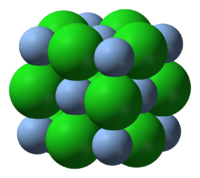AgCl
 |
|
 |
|
| Names | |
|---|---|
|
IUPAC name
Silver(I) chloride
|
|
| Other names | |
| Identifiers | |
|
3D model (JSmol)
|
|
| ChEBI | |
| ChemSpider | |
| ECHA InfoCard | 100.029.121 |
|
PubChem CID
|
|
| RTECS number | VW3563000 |
| UNII | |
|
|
|
|
| Properties | |
| AgCl | |
| Molar mass | 143.32 g·mol−1 |
| Appearance | White Solid |
| Density | 5.56 g cm−3 |
| Melting point | 455 °C (851 °F; 728 K) |
| Boiling point | 1,547 °C (2,817 °F; 1,820 K) |
| 520 μg/100 g at 50 °C | |
| Solubility | soluble in NH3, conc. HCl, conc. H2SO4, alkali cyanide, NH4CO3?, KBr, Na2S2O3; |
| −49.0·10−6 cm3/mol | |
|
Refractive index (nD)
|
2.071 |
| Structure | |
| halite | |
| Thermochemistry | |
|
Std molar
entropy (S |
96 J·mol−1·K−1 |
|
Std enthalpy of
formation (ΔfH |
−127 kJ·mol−1 |
| Hazards | |
| Safety data sheet | Fischer Scientific, Salt Lake Metals |
| NFPA 704 | |
| Related compounds | |
|
Other anions
|
silver(I) fluoride, silver bromide, silver iodide |
|
Except where otherwise noted, data are given for materials in their standard state (at 25 °C [77 °F], 100 kPa).
|
|
|
|
|
| Infobox references | |
insoluble in alcohol, dilute acids.
Silver chloride is a chemical compound with the chemical formula AgCl. This white crystalline solid is well known for its low solubility in water (this behavior being reminiscent of the chlorides of Tl+ and Pb2+). Upon illumination or heating, silver chloride converts to silver (and chlorine), which is signaled by greyish or purplish coloration to some samples. AgCl occurs naturally as a mineral chlorargyrite.
Silver chloride is easily synthesized by combining aqueous solutions of silver nitrate and sodium chloride.
The solid adopts the fcc NaCl structure, in which each Ag+ ion is surrounded by an octahedron of six chloride ligands. AgF and AgBr crystallize similarly. However, the crystallography depends on the condition of crystallization, primarily free silver ion concentration, as is shown on the pictures left (greyish tint and metallic lustre are due to partly reduced silver). AgCl dissolves in solutions containing ligands such as chloride, cyanide, triphenylphosphine, thiosulfate, thiocyanate and ammonia. Silver chloride reacts with these ligands according to the following illustrative equations:
Silver chloride does not react with nitric acid. Most complexes derived from AgCl are two-, three-, and, in rare cases, four-coordinate, adopting linear, trigonal planar, and tetrahedral coordination geometries, respectively.
...
Wikipedia

